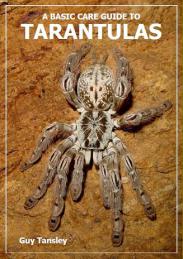
Only three species are described in Theraphosa Thorell, 1870. All are
large terrestrial species requiring larger a than normal-sized container.
T.
apophysis (Tinter, 1991) - Venezuela
Similar to T. blondi when adult but spiderlings and juveniles have pink colouration to the metatarsus
and tarsus giving this species the common name of pinkfoot goliath. Although not as heavily built as T.
blondi it may reach a larger size and should therefore be housed in similar conditions (see below). T.
apophysis has some of the most irritating urticating hairs of any species and being highly strung and nervous, it will readily use them for defence. Captive
breeding of this giant is still rare therefore they still command a high price.
T.
blondi (Latreille, 1804) - Venezuela, Brazil, Guyana
T.
blondi is the worlds largest recorded species of spider. Males have a greater legspan but are slimmer than the females. Not overly aggressive, the goliath
is more nervous but be aware that this species has very irritating urticating hairs that it will throw off at the slightest sign of disturbance. Care should be taken especially when cleaning out the
container as the hairs can cause a severe reaction. For their size, mating is usually a rather subdued affair with little risk to the male if both are receptive. Eggsacs contain few eggs (around 70)
but the resulting spiderlings are huge, having a 2 cm leg span after their first moult. T. blondi is a ravenous feeder throughout its life and is fast growing. The enclosure shouldn't be too high as these spiders like to wander and a fall from a tank wall can prove fatal. Wild
caught specimens should be avoided as these seem to take time to settle in captivity and this shouldn't be a problem as there are plenty of captive bred stock available. Recently a species of phorid
fly was discovered that has a very close relationship with the goliath, more can be found here. Can reach up to 25 cm leg span (worlds largest spider) and due to its large size, it requires a larger enclosure. A retreat in the form
of cork bark or a half flower pot is a must as this species can take some time to settle in captivity. High humidity is not essential but the substrate should not be allowed to dry out completely. A
large open water dish is also a must (see here for more info on
housing).
T. stirmi (coming soon).

